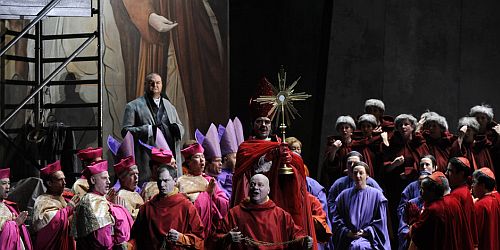 Germany Puccini, Tosca: Soloists, Sächsischer Staatsopernchor Dresden, Kinderchor der Sächsischen Staatsoper Dresden, Sächsische Staatskapelle Dresden/Julian Kovatchev (conductor), Semperoper, Dresden, Germany , 16.5.2015 (MC)
Germany Puccini, Tosca: Soloists, Sächsischer Staatsopernchor Dresden, Kinderchor der Sächsischen Staatsoper Dresden, Sächsische Staatskapelle Dresden/Julian Kovatchev (conductor), Semperoper, Dresden, Germany , 16.5.2015 (MC)
Cast:
Tosca: Tatiana Serjan
Mario: Mikhail Agafonov
Scarpia: Marco Vratogna
Angelotti: Tomislav Lucic
Spoletta: Tom Martinsen
Sciarrone: Evan Hughes
Schliesser: Pavol Kuban
Hirt: Luis Herrich
Production:
Musical Director: Julian Kovatchev
Director: Johannes Schaaf
Set Design: Christof Cremer
Costumes: Petra Reinhardt
Lighting: Guido Petzold
Choir: Jorn Hinnerk Andresen
Kinderchor: Claudia Sebastian-Bertsch
Dramaturgy: Ilsedore Reinsberg
Sung in Italian with German surtitles.
It’s always a pleasure to visit the Semper Opera House, Dresden especially for this splendid Johannes Schaaf’s 2009 production of Puccini’s Tosca. I must have attended a dozen or so productions of this perennially popular opera with its turbulent love affair, attempted rape and fatal conclusion all set against a backdrop of political intrigue and menace. I’ve seen and thoroughly enjoyed Luc Bondy’s production of Tosca at the Royal Opera House, London and the Bayerischen Staatsoper, Munich, and also relished Carl Riha’s production at the Staastoper, Berlin.
The test of a good staging is whether the opera still feels fresh and this stimulating Johannes Schaaf revival just flew by thanks to Julian Kovatchev’s splendidly judged pacing and generally excellent performances from the Staatsoper cast. Christof Cremer’s staging was convincing, using a predominantly traditional setting of Rome in 1800 delivered a resourceful and dramatic effect. Much of the staging was minimalist consisting of a grimy battleship-grey, such a favourite with designers, centred around a hinged iron grill on the floor that served as the entrance to both the crypt of the church and baron Scarpia’s dungeon. Petra Reinhardt’s costumes looked suitably of the period with grey being the principal choice of colour providing a stark contrast to the powerful Scarpia’s vivid red costume.
In the title role, Russian dramatic coloratura soprano Tatiana Serjan got off to a sluggish start with ‘Non la sospiri, la nostra casetta’ initially a touch unsteady and sounding shrill in her high register. By ‘Vissi d’arte’ she had grown in assurance, gaining in fluidity and becoming less harsh. Especially attractive is the soprano’s creamy mid-register and her pleasingly clear diction. Serjan can glide quickly to her top; but most remarkable is the strength of her projection that can fill all corners of the house.
Russian Mikhail Agafonov in the role of Mario is an enthusiatic and rather engaging bright lyric tenor. For his romanza ‘Recondita armonia’ the tenor had not quite got into his stride but soon recovered to give an assured performance of dramatic energy, satisfying in emotional investment. In his arias ‘E lucevan Le Stelle’ and ‘O dolci mani’ the persuasive Agafonov provided a generous degree of passion and significant emotional pain.
With his shaved head and vivid red tunic with black riding boots the Italian baritone Marco Vratogna certainly looked the part as the menacing Chief of Police scheming, depraved and violently lustful. Disappointingly Vratogna looked out of his depth especially with his wooden acting; having said that Scarpias such as Bryn Terfel have set the bar extremly high. Only a forensic scientist would know how Scarpia managed to suffer a fatal stabbing without any blood staining his white shirt and how Scarpia scaled to the top of the painter’s scaffolding without it overtoppling is another puzzle. I felt the death of Tosca by throwing herself off the non existant battlements was most ineffective, conversely my wife thought it was dramatic.
The remainder of the cast gave creditable performances without anyone especially standing out. I felt the singing of the Staatsoper chrous was top drawer and I’ll never forget the vivdly colourful and moving scene when the substantial church procession entered the stage singing the Te Deum. Under the assured baton of Julian Kovatchev the talanted Staatskapelle Dresden provided expressive and dramatic playing of an elevated level rarely surpassed in an opera house. A slight grumble was Maestro Kovatchev not leaving room for audience applause after the arias and thus detracting from performance atmosphere.
Michael Cookson
